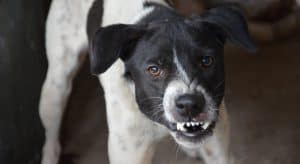Dehydration in your dog occurs when the dog’s body loses fluids and electrolytes that are vital for your dog to maintain the proper functioning of his organs. Dogs dehydrate rapidly and do not recover as easily as humans do if they become dehydrated. If a dehydrated dog is left too long in this predicament, it can lead to organ failure, shock, and even death!
In fact, if a dog’s bodily fluid were to decrease by only 5%, you could begin to see indicators of dehydration. The dog’s eyes and mouth may look lethargic and his nose will be dry and his skin will become loose.
Video on How to Check Your Dog for Dehydration

How To Check Your Dog For Dehydration
Remember that ‘loose skin’ is a sign of dehydration. We can take this symptom and use it as a method to tell if our dog is sick.
- Have your dog either sitting or standing.
- Place your thumb and index finger on the scruff of the dog’s neck.
- Pull upward on the skin.
- Then release your fingers so the skin will drop back down into position.
- If the dog is properly hydrated, the skin should spring back immediately into its previous position. This should literally happen within one or two seconds.
- If the scruff falls back slowly, then the dog is dehydrated.
Please note that if your dog is older, unhealthy, skinny, or overweight it may be difficult to check for dehydration with this method. An older, unhealthy or thin dog’s skin may fall back slowly just because he has lost elasticity, not because of dehydration. Also, an overweight dog’s skin can be difficult to pull upward in order to detect dehydration.
.
Alternative Method To Check For Dehydration
An alternative method would be to feel the dog’s gums to see if they are dry or sticky. If this is the case then your dog is likely dehydrated.
Valuable Tip
A valuable tip would be to frequently lift the scruff of your dog’s neck and observe it rise and fall. This way you can get a ‘baseline of wellness’ for your dog.
If you know how ‘your’ dog’s scruff looks in a normal circumstance (‘his normal’) you will be able to see the difference in the future if your dog is dehydrated. It may not look like the textbook example of dehydration but it is how ‘your’ dog’s skin movement looks like when he is dehydrated.
Know your dog’s baseline of wellness for dehydration by frequently using this technique. Remember, dehydration is serious and life-threatening. If your dog is suffering from dehydration you must immediately consult a veterinarian.
.
Reasons Your Dog Can Become Dehydrated
- If your dog does not get enough water during exercise
- If your dog is out in the hot sun he can also dehydrate
- Excessive panting or sweating for any reason can cause dehydration to occur.
- Also, vomiting or severe diarrhea can also cause dehydration as your dog loses lots of fluids.
Almost every dog will experience vomiting and or diarrhea during its lifetime. It could stem from something as simple as eating something that made them sick while out and about in the backyard or maybe they could have picked up something as complex as a bacterial or viral infection. Also, some breeds of dogs have very sensitive stomachs and experience GI discomfort regularly such as the Boston Terrier. Also as a dog ages, he can develop inflammatory bowel disease, which will cause serious vomiting and diarrhea on a frequent basis.
Whatever the case may be, knowing how to check for dehydration is a basic skill required in order to determine how you can tell if your dog is sick.
.
For Further Information
For a complete, encyclopedic survival guide to all aspects of dog health, from preventative care to choosing a vet to doggie First Aid (even the canine Heimlich maneuver!), you should take a look at The Ultimate Guide to Dog Health.
It’s a survival guide for knowledgeable, effective, and life-saving dog care. This manual keeps your dog’s health and well-being firmly within your control – which is exactly where you want it to be.







